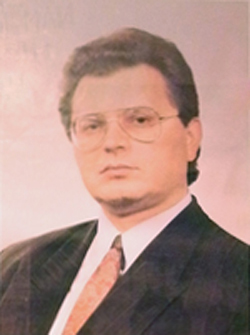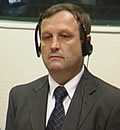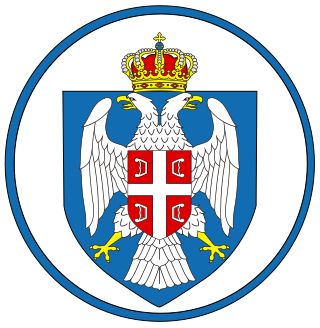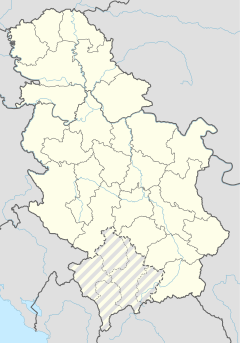
Ruma is a town and municipality in the Srem District of the Autonomous Province of Vojvodina, Serbia. As of 2011, the town has a population of 30,076, while the municipality has a population of 54,339.

The Yugoslav Wars were a series of separate but related ethnic conflicts, wars of independence, and insurgencies that took place in the SFR Yugoslavia from 1991 to 2001. The conflicts both led up to and resulted from the breakup of Yugoslavia, which began in mid-1991, into six independent countries matching the six entities known as republics that had previously constituted Yugoslavia: Slovenia, Croatia, Bosnia and Herzegovina, Montenegro, Serbia, and Macedonia. SFR Yugoslavia's constituent republics declared independence due to unresolved tensions between ethnic minorities in the new countries, which fuelled the wars. While most of the conflicts ended through peace accords that involved full international recognition of new states, they resulted in a massive number of deaths as well as severe economic damage to the region.

Milan Babić was a Croatian Serb politician and war criminal who served as the first president of the Republic of Serbian Krajina, a self-proclaimed state largely populated by Serbs of Croatia that wished to break away from Croatia during the Croatian War of Independence.

Vojislav Šešelj is a Serbian politician, founder and president of the far-right Serbian Radical Party (SRS) and a convicted war criminal. Between 1998 and 2000, he served as the deputy prime minister of Serbia.

Milan Martić is a Croatian Serb politician and war criminal who served as the president of the unrecognized Republic of Serbian Krajina between 1994 and 1995, during the Croatian War of Independence.

Hrtkovci is a village located in the municipality of Ruma, Serbia. As of 2011 census, it has a population of 3,036 inhabitants.

The White Eagles, also known as the Avengers, were a Serbian paramilitary group associated with the Serbian National Renewal (SNO) and the Serbian Radical Party (SRS). The White Eagles fought in Croatia and Bosnia and Herzegovina during the Yugoslav Wars.
The Voćin massacre was the killing of 43 civilians in Voćin, Croatia, by the Serbian White Eagles paramilitary unit on 13 December 1991, during the Croatian War of Independence. The massacre was carried out after the unit was ordered to abandon the village before the Croatian Army recaptured the area in Operation Papuk-91. All the victims were local Croats, save one Serb, who had tried to protect his neighbours. Gunfire was the leading cause of death, though some of the victims were killed with axes or chainsaws, or were burned to death. The victims exhibited signs of torture and were left unburied. On the night of 13–14 December, the White Eagles dynamited a 550-year-old church in the village.
The Velepromet camp was a detention facility established in the final days of the Battle of Vukovar during the Croatian War of Independence. The camp was set up by the Yugoslav People's Army (JNA), which shared control of the facility with Croatian Serb rebels. The facility, originally an industrial storage site, was located on the southern outskirts of the city of Vukovar, in close proximity to the JNA barracks. It consisted of eight warehouses surrounded by a wire fence, and was established on 16 November 1991, when the first detainees were brought there.

Slobodan Milošević was a Serbian–Yugoslav politician who was the president of Serbia from 1989 to 1997 and president of the Federal Republic of Yugoslavia from 1997 until his оverthrow in 2000. Formerly a high-ranking member of the League of Communists of Serbia (SKS) during the 1980s, he led the Socialist Party of Serbia from its foundation in 1990 until his death in 2006. Milošević played a major role in the Yugoslav Wars. During his reign, numerous anti-government and anti-war protests took place, and hundreds of thousands deserted the Milošević-controlled Yugoslav People's Army, leading to mass emigration from Serbia. During the NATO bombing of Yugoslavia in 1999, Milošević was charged by the International Criminal Tribunal for the former Yugoslavia (ICTY) for war crimes in connection with the Bosnian War, the Croatian War of Independence, and the Kosovo War. He became the first sitting head of state to be charged with war crimes.

Serbia was involved in the Yugoslav Wars, which took place between 1991 and 1999—the war in Slovenia, the war in Croatia, the war in Bosnia, and Kosovo. From 1991 to 1997, Slobodan Milošević was the President of Serbia. Serbia was part of the Federal Republic of Yugoslavia (FRY). The International Criminal Tribunal for the Former Yugoslavia (ICTY) has established that Milošević was in control of Serb forces in Bosnia and Herzegovina and Croatia during the wars which were fought there from 1991 to 1995.

The Zvornik massacre refers to acts of mass murder and violence committed against Bosniaks and other non-Serb civilians in Zvornik by Serb paramilitary groups at the beginning of the Bosnian War in 1992. It was part of a wider campaign of ethnic cleansing in the Bosnian War: by one estimate, 40,000 Bosniaks were expelled from the Zvornik district.
The Erdut killings were a series of murders of 37 Hungarian and Croat civilians in the village of Erdut, Croatia committed by Croatian Serb forces and Serb Volunteer Guard paramilitaries between November 1991 and June 1992, during the Croatian War of Independence. Twenty-two Hungarians and 15 Croats were killed. The first killings occurred on 10 November 1991, when twelve civilians died. Eight more were killed over the following several days. Five more civilians were killed on 10 December, and another seven on 16 December. Four others were killed on 21 February 1992 and the final one was killed on 3 June. The bodies of these victims were either buried in mass graves or thrown into nearby wells.
Humanitarian Law Center (HLC) is the Serbian non-governmental organisation with offices in Belgrade, Serbia, and Pristina, Kosovo. It was founded in 1992 by Nataša Kandić to document human rights violations across the former Yugoslavia in armed conflicts in Croatia, Bosnia and Herzegovina, and, later, Kosovo.

Ethnic cleansing occurred during the Bosnian War (1992–95) as large numbers of Bosnian Muslims (Bosniaks) and Bosnian Croats were forced to flee their homes or were expelled by the Army of Republika Srpska and Serb paramilitaries. Bosniaks and Bosnian Serbs had also been forced to flee or were expelled by Bosnian Croat forces, though on a restricted scale and in lesser numbers. The UN Security Council Final Report (1994) states while Bosniaks also engaged in "grave breaches of the Geneva Conventions and other violations of international humanitarian law", they "have not engaged in "systematic ethnic cleansing"". According to the report, "there is no factual basis for arguing that there is a 'moral equivalence' between the warring factions".
Anti-Croat sentiment or Croatophobia is discrimination or prejudice against Croats as an ethnic group and it also consists of negative feelings towards Croatia as a country.

Flavia Lattanzi is an Italian lawyer specialized in international law who is an ad litem judge at the International Criminal Tribunal for the former Yugoslavia (ICTY) since 2007 and professor at the Roma Tre University. Between 2003 and 2007, she served as an ad litem judge at the International Criminal Tribunal for Rwanda.

Tomislav Žigmanov is a Serbian politician serving as minister of human and minority rights and social dialogue since 2022. An ethnic Croat, he has been the president of the Democratic Alliance of Croats in Vojvodina (DSHV) since 2015. He served in the National Assembly of Serbia from 2016 to 2020, and again from 1 August 2022 to 25 October 2022.
Jovo Ostojić was a politician and paramilitary leader in Serbia. He served two terms in the National Assembly of Serbia as a member of the far-right Serbian Radical Party.
The Komić killings refers to the mass murder of elderly Serb civilians from the village of Komić in August 1995 by members of the Croatian Army (HV), five days after Operation Storm.














